Potrebujeme váš súhlas na využitie jednotlivých dát, aby sa vám okrem iného mohli ukazovať informácie týkajúce sa vašich záujmov. Súhlas udelíte kliknutím na tlačidlo „OK“.
ASTM D1067-11
Standard Test Methods for Acidity or Alkalinity of Water
Automaticky preložený názov:
Štandardné skúšobné metódy pre kyslosť alebo zásaditosť vody
NORMA vydaná dňa 1.4.2011
Informácie o norme:
Označenie normy: ASTM D1067-11
Poznámka: NEPLATNÁ
Dátum vydania normy: 1.4.2011
Kód tovaru: NS-16218
Počet strán: 8
Približná hmotnosť: 24 g (0.05 libier)
Krajina: Americká technická norma
Kategória: Technické normy ASTM
Kategórie - podobné normy:
Anotácia textu normy ASTM D1067-11 :
Keywords:
acidity, alkalinity, titrations, water, Acidity, alkalinity, pH--water, Water analysis, ICS Number Code 13.060.50 (Examination of water for chemical substances)
Doplňujúce informácie
| Significance and Use | ||||||||||||||||||
|
Acidity and alkalinity measurements are used to assist in establishing levels of chemical treatment to control scale, corrosion, and other adverse chemical equilibria. Levels of acidity or alkalinity are critical in establishing solubilities of some metals, toxicity of some metals, and the buffering capacity of some waters. |
||||||||||||||||||
| 1. Scope | ||||||||||||||||||
|
1.1 These test methods cover the determination of acidity or alkalinity of all types of water. Three test methods are given as follows:
1.2 In all of these test methods the hydrogen or hydroxyl ions present in water by virtue of the dissociation or hydrolysis of its solutes, or both, are neutralized by titration with standard alkali (acidity) or acid (alkalinity). Of the three procedures, Test Method A is the most precise and accurate. It is used to develop an electrometric titration curve (sometimes referred to as a pH curve), which defines the acidity or alkalinity of the sample and indicates inflection points and buffering capacity, if any. In addition, the acidity or alkalinity can be determined with respect to any pH of particular interest. The other two methods are used to determine acidity or alkalinity relative to a predesignated end point based on the change in color of an internal indicator or the equivalent end point measured by a pH meter. They are suitable for routine control purposes. 1.3 When titrating to a specific end point, the choice of end point will require a careful analysis of the titration curve, the effects of any anticipated changes in composition on the titration curve, knowledge of the intended uses or disposition of the water, and a knowledge of the characteristics of the process controls involved. While inflection points (rapid changes in pH) are usually preferred for accurate analysis of sample composition and obtaining the best precision, the use of an inflection point for process control may result in significant errors in chemical treatment or process control in some applications. When titrating to a selected end point dictated by practical considerations, (1) only a part of the actual neutralizing capacity of the water may be measured, or (2) this capacity may actually be exceeded in arriving at optimum acidity or alkalinity conditions. 1.4 A scope section is provided in each test method as a guide. It is the responsibility of the analyst to determine the acceptability of these test methods for each matrix. 1.5 Former Test Methods C (Color-Comparison Titration) and D (Color-Change Titration After Boiling) were discontinued. Refer to Appendix X4 for historical information. 1.6 The values stated in SI units are to be regarded as standard. No other units of measurement are included in this standard. 1.7 This standard does not purport to address all of the safety concerns, if any, associated with its use. It is the responsibility of the user of this standard to establish appropriate safety and health practices and determine the applicability of regulatory limitations prior to use. 7.1 This test method is applicable to the determination of acidity or alkalinity of all waters that are free of constituents that interfere with electrometric pH measurements. It is used for the development of a titration curve that will define inflection points and indicate buffering capacity, if any. The acidity or alkalinity of the water or that relative to a particular pH is determined from the curve. 16.1 This test method covers the rapid, routine control measurement of acidity or alkalinity to predesignated end points of waters that contain no materials that buffer at the end point or other materials that interfere with the titration by reasons that may include color or precipitation. 25.1 This test method is intended specifically for mine drainage, surface streams receiving mine drainage, industrial waste waters containing waste acids and their salts, and similar waters bearing substantial amounts of ferrous iron or other polyvalent cations in a reduced state. 25.2 Because the oxidation and hydrolysis of ferrous iron generate acidity, a reliable measure of acidity or alkalinity is obtained only when complete oxidation is achieved and hydrolysis to ferric salts is completed (see Appendix X3). In many instances, the concentration of ferrous iron is such that a 2-min boiling period is not sufficient to assure complete oxidation. In this test method, hydrogen peroxide is added prior to boiling to accelerate the chemical reactions needed for equilibrium. 25.3 This test method may be used to determine approximate alkali requirements for neutralization and to assure comparability of results when both alkaline and acid flows are under consideration in mine drainage treatment. |
||||||||||||||||||
| 2. Referenced Documents | ||||||||||||||||||
|
Podobné normy:
Historická
1.11.2012
Historická
1.5.2009
Historická
1.6.2013
Historická
15.6.2013
Historická
1.5.2013
Historická
15.11.2008


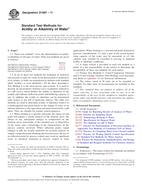
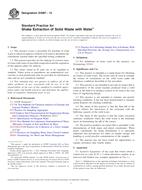 ASTM D3987-12
ASTM D3987-12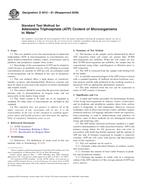 ASTM D4012-81(2009)..
ASTM D4012-81(2009)..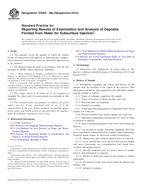 ASTM D4025-08a(2013)..
ASTM D4025-08a(2013)..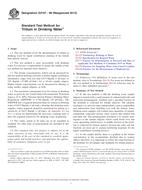 ASTM D4107-08(2013)..
ASTM D4107-08(2013)..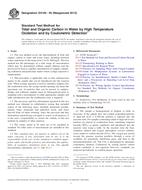 ASTM D4129-05(2013)..
ASTM D4129-05(2013)..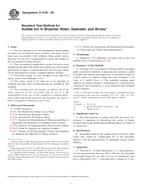 ASTM D4130-08
ASTM D4130-08
 Cookies
Cookies
